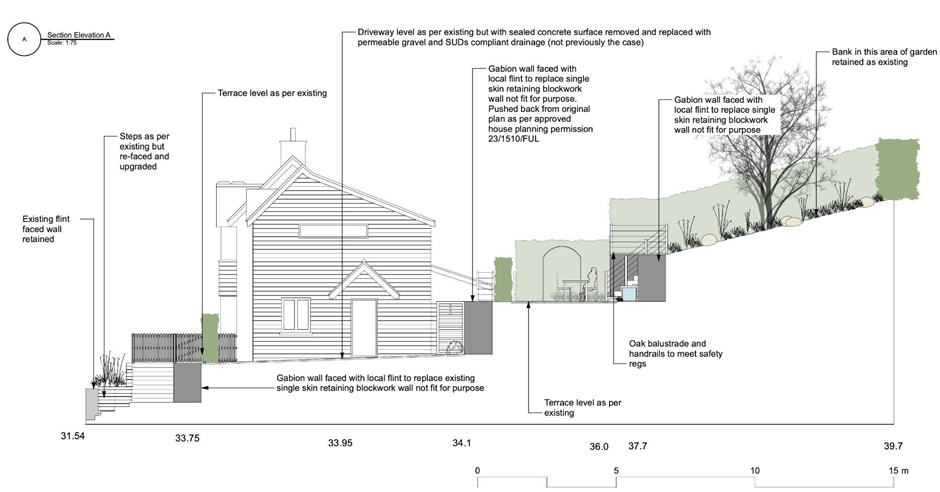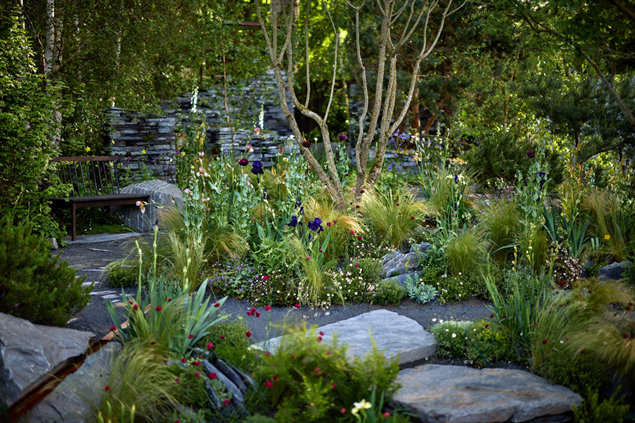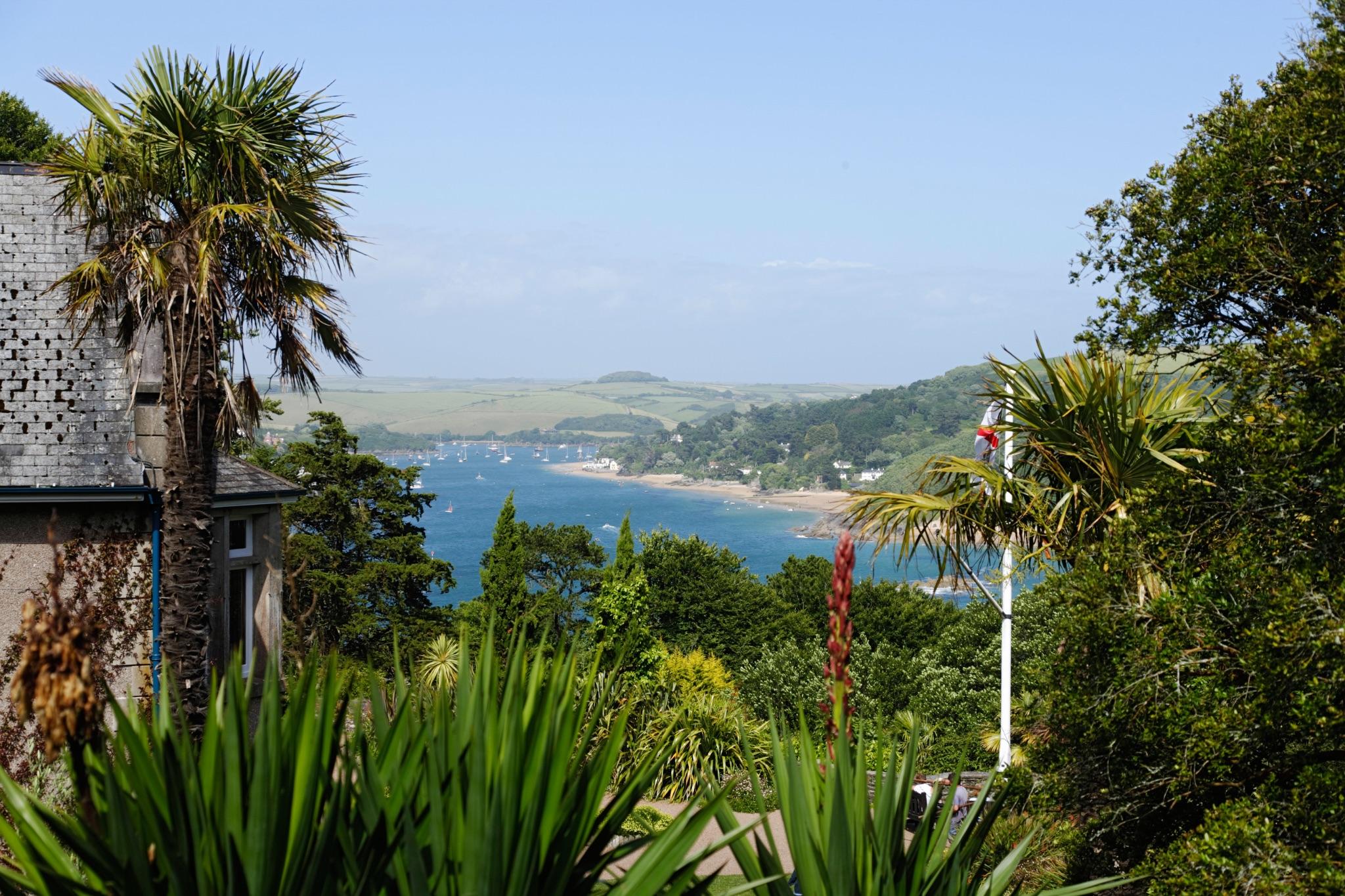In a part of the world where life is often lived outdoors, it’s no surprise that gardens hold a special place in the hearts of many in Devon. Increasingly, Devon’s homeowners are seeking to extend their living spaces into the garden, fostering a closer relationship with the natural world. Like other creative pursuits, many draw on Devon’s unique and varied landscape to provide a rich source of inspiration for their garden transformations.
From the sweeping views and sense of freedom found high on Dartmoor and Exmoor, to the quiet, dappled shade of ancient woodlands, and the relaxed charm of hidden sandy coves, Devon’s unique ecosystems offer a wealth of natural elements to draw upon. This backdrop is further enriched by Devon’s deep-rooted horticultural heritage - where colourful cottage gardens and grand countryside estates reflect centuries of gardening tradition.
Today, garden designers in Devon draw on both the landscape and its heritage to create outdoor spaces that are both beautiful and sensitively connected to their surroundings. Whether it’s a contemporary cottage garden, a relaxed coastal retreat, or a sprawling countryside estate, successful landscape design in Devon requires a careful balance - reflecting the character of the land, respecting the site’s history, and supporting a modern lifestyle.
Thinking of transforming your garden in Devon or the South West? This guide explores how to work with the land, navigate local environmental considerations, and find the right designer to bring your vision to life.
Overbeck’s in Devon overlooks the stunning South Devon coastline and hills beyond.
Popular garden styles in Devon
Devon’s rich gardening heritage, combined with its diverse landscapes and varied microclimates, naturally gives rise to a wide array of garden styles. This variety is beautifully showcased in some of the county’s most celebrated public gardens - from the timeless formality of Edwin Lutyens’ design at Castle Drogo, to the naturalistic woodland setting of Stone Lane Gardens on the edge of Dartmoor, and the exotic, sub-tropical planting at Overbeck’s in Salcombe. A deep understanding of each place - its soils, climate, history and character - is central to shaping gardens that resonate with both its users and the wider landscape.
In private gardens across Devon, this same diversity is reflected in the styles homeowners are drawn to. English cottage gardens, with their layered planting, soft structure, and seasonal abundance, remain popular and suit the character of Devon’s famous chocolate-box villages. However, there is a growing shift towards more naturalistic, sustainable designs. These often take cues from the surrounding landscape, using native or climate-resilient planting and local materials that feel rooted in place.
Coastal gardens favour hardy, salt-tolerant species and sleek, relaxed layouts that suit breezy, sun-drenched sites, while in more rural locations set within Devon’s rolling countryside, you’ll find contemporary interpretations of classic English cottage gardens - elegant, yet designed for modern living. Increasingly, gardens in Devon are not just ornamental, but lived-in spaces: places to relax, gather, and feel connected to the land.
At Foxholes Hill, Clare Shaw from Matthew Childs Design, has created a beautiful, relaxed family garden escape which melts seamlessly into South Devon’s coastal landscape beyond.
Photo credit: Barc Architects
Importance of sustainable/eco-friendly landscaping in the South West
With two National Parks, five National Landscapes, and two World Heritage Sites, Devon’s natural environment is not only strikingly beautiful but also highly sensitive and deserving of careful stewardship. As a result, sustainability and eco-friendly landscaping are becoming central to responsible garden design across the region.
Working with the natural conditions of each site - using native and climate-resilient plants, supporting local biodiversity, and managing water and soil responsibly - is essential. These principles are best realised with the guidance of an experienced garden designer who understands how to balance ecological integrity with aesthetic ambition and practical requirements.
Case study: The Old Police House, Beer by Matthew Childs Design
Set within the East Devon National Landscape, the garden at The Old Police House in Beer - designed by Matthew Childs Design - demonstrates how sustainable principles can guide the design of a beautiful, functional outdoor space on a challenging site.
Key sustainable practices featured in the project:
- Respecting the site’s natural topography to reduce excavation and soil disturbance
- Using locally sourced, natural materials, such as flint, to lower the project’s carbon footprint
- Converting the driveway to a permeable surface that is SUDS (Sustainable Urban Drainage System) compliant, helping to manage rainwater sustainably and reduce runoff
- Incorporating pollinator-friendly species to support local ecosystems
- Introducing water to provide habitat and sensory appeal
- Planning for the future with climate-adapted plants and robust, lasting materials
Engaging an experienced garden designer early on in the process helps ensure that sustainability is not an afterthought, but a guiding principle, helping to preserve Devon’s unique and precious landscapes.
A layered garden of natural materials, resilient plants, and a permeable driveway designed to work with the land’s natural contours and manage water sustainably. Sectional elevation for The Old Police House, by Matthew Childs Design.
Incorporating Devon's natural beauty
A well-designed Devon garden doesn’t compete with the landscape - it settles into the land. Whether nestled into a wooded valley, perched on windswept coastal cliffs, or set against the backdrop of boulder-strewn moorland, it should feel like an authentic extension of its environment. Each unique setting offers opportunities for creativity through thoughtful, site-responsive design.
Ideas for highlighting Devon’s beauty in your garden design:
- Frame the landscape: Design with long views in mind - opening up sightlines to hills, woodlands or coastlines, and choosing plants that blend effortlessly into the scenery beyond.
- Crafted local materials: Incorporate stone, timber, and other materials sourced and crafted locally to root your garden in Devon’s heritage and character.
- Natural palette: Planting palettes can take cues from the nearby coast or countryside, with wind-tolerant species, grasses, and wildflower meadows that echo the land’s textures and hues.
- Encourage nature: Support biodiversity with pollinator-friendly plants and water features like wildlife ponds or natural swimming ponds, creating a cultivated sanctuary that mirrors Devon’s wild countryside.

A path built from locally sourced boulders leads to a peaceful rest stop under dappled woodland shade. Photo credit: Alister Thorpe
FAQs
- What is the most popular garden style in Devon?
- Across the region, there is a clear trend: while traditional English cottage gardens still hold a nostalgic appeal, many homeowners are moving towards more naturalistic, sustainable designs with a contemporary touch. These often echo Devon’s wild beauty and require less intensive maintenance than densely planted cottage styles. Increasingly, interest and personality in gardens are coming from subtle details, such as texture in planting, the patina and quality of materials, or a natural water feature that provides movement and sound, rather than from formal structure or intense ornamental planting schemes.
- How do I design a garden for coastal conditions?
- Designing for a coastal garden involves working with some unique environmental challenges, but these can also offer great opportunities for design. Some considerations include:
Exposure: Salt-laden winds mean it’s essential to choose salt-tolerant plants that can thrive in tough conditions, such as Perovskia ‘Blue Spire’, Salvia nemorosa and grasses, such as Stipa tenuissima. More sensitive areas may need additional protection, so consider introducing wind breaks through structured planting or discreet screening.
Light: Coastal sites can often receive intense summer sun, so selecting drought-tolerant species and using materials that won’t overheat or fade from UV exposure is key. Ensure you include shaded seating spots to escape the heat of the midday sun.
Geology: Sloped or cliffside gardens may need terracing or careful planting to stabilise soil and manage runoff, but can also offer spectacular design potential with sweeping views and dynamic planting schemes. Similarly, beachside plots can often be sited on sandy soils, which offer very little support for planting and hard-landscaping. You will likely need to involve specialists to help navigate these tricky conditions safely and sensitively.
- What plants work best in Devon’s soil?
- Devon’s soils are incredibly diverse, shaped by its geology, topography, and climate. The best plants for your garden will depend on your specific location and conditions - whether you're by the coast, on the moor, or in a sheltered valley. Here are some general pointers:
- Sandy or free-draining soils (especially near the coast):
- Choose salt- and wind-tolerant species like Armeria maritima (Sea thrift), Oenothera lindheimeri (Gaura), grasses, and sedges. Many Mediterranean or silver-leaved plants, such as Rosemary will do well in these conditions. Add airy height with plants such as Verbena bonariensis or Verbena hastata.
- Sheltered woodland valleys:
- These spots can support a wide range of lush plants including evergreen ferns, such as Blechnum spicant and soft grasses, such as Luzula nivea. Intersperse the green foundation with pops of white or coloured flowers, such as Digitalis purpurea f. albiflora (white foxglove) to brighten shady spots. Introduce a burst of colour in Spring with a mix of Galanthus (snowdrop), Cyclamen coum, Helleborus and a beautiful carpet of bluebells.
- Acidic, damp soils (common on Dartmoor and Exmoor):
- Ideal for native, low-pH loving plants including heathers and ferns, such as Dryopteris filix-mas or Polystichum setiferum. Add delicacy with irises, such as Iris foetidissima or larger perennials such as Bistorta amplexicaulis ‘Alba’. Use Anemones to provide late season interest and Cornus for dramatic Winter stems.
- Wherever you are in Devon, it’s worth testing your soil’s pH and drainage, then selecting plants that are naturally suited - or working with a local garden designer in Devon who understands the nuances of the region and will choose the right plants for your site conditions.
- How do I choose a professional garden designer in Devon?
- The most reliable way to find a qualified designer is through the Society of Garden and Landscape Designers (SGLD), the UK’s only professional body dedicated to garden design. All members meet strict professional standards, ensuring you work with an accredited expert.
- Look for garden designers who’ve worked in Devon before and explore their portfolios to see if their style aligns with your vision. Most will outline their design philosophy on their website - does it resonate with you? If their work inspires you, get in touch to start a conversation. Since you’ll be working closely together, it’s important to choose someone whose approach and personality feel like a good fit.
Matthew Childs Design have a studio in Beer East Devon and work throughout the county on projects of all sizes.
At Foxholes Hill, the climate resilient planting scheme designed by Clare Shaw from Matthew Childs Design provides visual interest and textural contrast. Plants such as Santolina, Armeria and Thymus are well-adapted to the sunny, sandy conditions and pick up on the warm, golden hues of Exmouth’s coastline. Photo credit: Barc Architects

